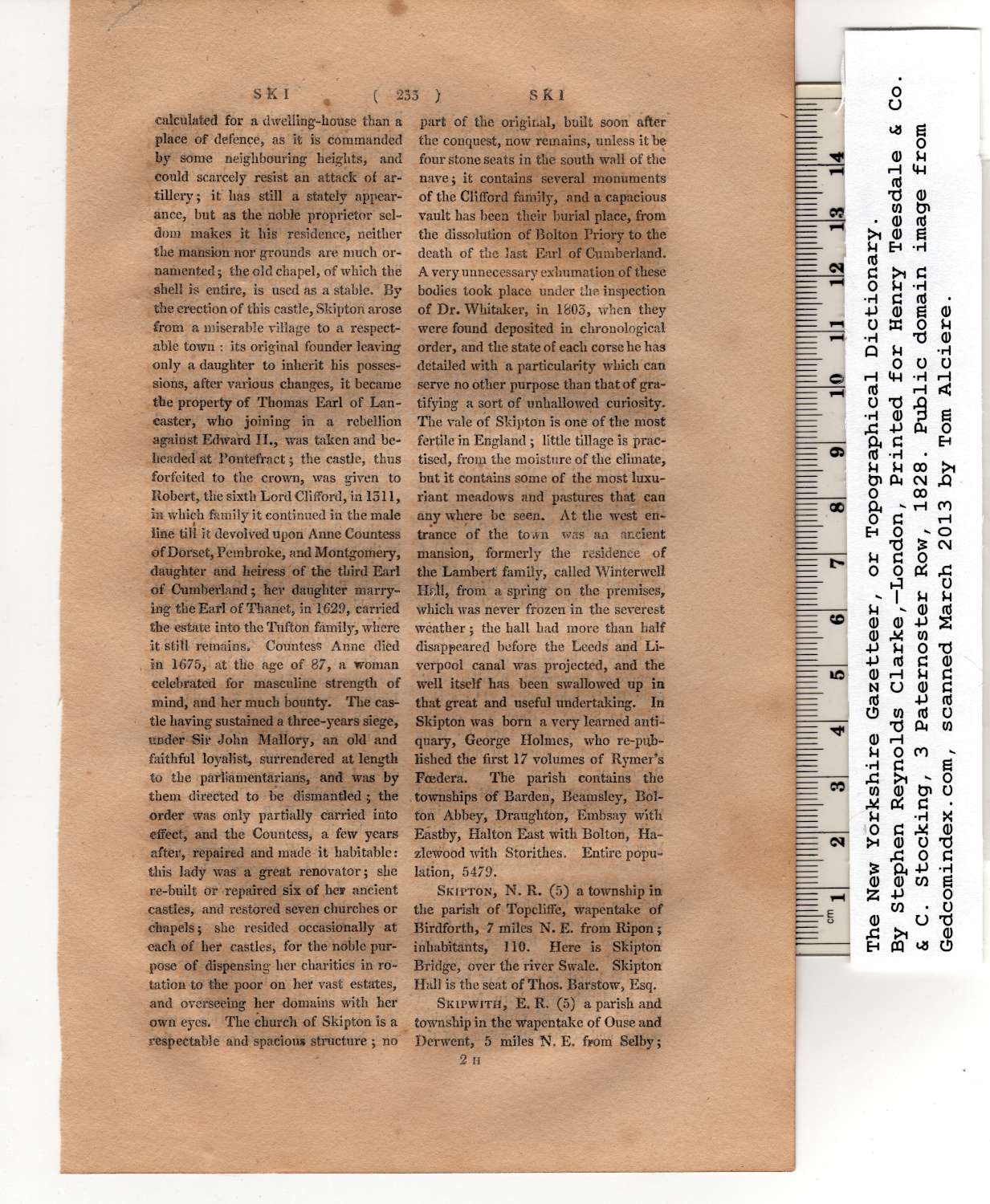|
calculated for a dwelling-house than a
place of defence, as it is commanded
by some neighbouring heights, and
could scarcely resist an attack of ar-
tillery; it has still a stately appear-
ance, but as the noble proprietor sel-
dom makes it his residence, neither
the mansion nor grounds are much or-
namented; the old chapel, of which the
shell is entire, is used as a stable. By
the erection of this castle, Skipton arose
from a miserable village to a respect-
able town : its original founder leaving
only a daughter to inherit his posses-
sions, after various changes, it became
the property of Thomas Earl of Lan-
caster, who joining in a rebellion
against Edward II., was taken and be-
headed at Pontefract; the castle, thus
forfeited to the crown, was given to
Robert, the sixth Lord Clifford, in 1311,
in which family it continued in the male
line till it devolved upon Anne Countess
of Dorset, Pembroke, and Montgomery,
daughter and heiress of the third Earl
of Cumberland; her daughter marry-
ing the Earl of Thanet, in 1629, carried
the estate into the Tufton family, where
It still remains. Countess Anne died
In 1675, at the age of 87, a woman
celebrated for masculine strength of
mind, and her much bounty. The cas-
tle having sustained a three-years siege,
under Sir John Mallory, an old and
faithful loyalist, surrendered at length
to the parliamentarians, and was by
them directed to be dismantled ; the
order was only partially carried into
effect, and the Countess, a few years
after, repaired and made it habitable:
this lady was a great renovator; she
re-built or repaired six of her ancient
castles, and restored seven churches or
chapels; she resided occasionally at
each of her castles, for the noble pur-
pose of dispensing her charities in ro-
tation to the poor on her vast estates,
and overseeing her domains with her
own eyes. The church of Skipton is a
respectable and spacious structure ; no
part of the original, built soon after
the conquest, now remains, unless it be
four stone seats in the south wall of the
nave; it contains several monuments
of the Clifford family, and a capacious
vault has been their burial place, from
the dissolution of Bolton Priory to the
death of the last Earl of Cumberland.
A very unnecessary exhumation of these
bodies took place under the inspection
of Dr. Whitaker, in 1803, when they
were found deposited in chronological
order, and the state of each corse he has
detailed with a particularity which can
serve no other purpose than that of gra-
tifying a sort of unhallowed curiosity.
The vale of Skipton is one of the most
fertile in England; little tillage is prac-
tised, from the moisture of the climate,
but it contains some of the most luxu-
riant meadows and pastures that can
any where be seen. At the west en-
trance of the town was an ancient
mansion, formerly the residence of
the Lambert family, called Winterwell
Hall, from a spring on the premises,
which was never frozen in the severest
weather; the hall had more than half
disappeared before the Leeds and Li-
verpool canal was projected, and the
well itself has been swallowed up in
that great and useful undertaking. In
Skipton was born a very learned anti-
quary, George Holmes, who re-pub-
lished the first 17 volumes of Rymer’s
Foedera. The parish contains the
townships of Barden, Beamsley, Bol-
ton Abbey, Draughton, Embsay with
Eastby, Halton East with Bolton, Ha-
zlewood with Storithes. Entire popu-
lation, 5479. |
Skipton, N. R. (5) a township in
the parish of Topcliffe, wapentake of
Birdforth, 7 miles N. E. from Ripon;
inhabitants, 110. Here is Skipton
Bridge, over the river Swale. Skipton
Hall is the seat of Thos. Barstow, Esq.
Skipwith, E. R. (5) a parish and
township in the wapentake of Ouse and
Derwent, 5 miles N. E. from Selby;
2 H |
